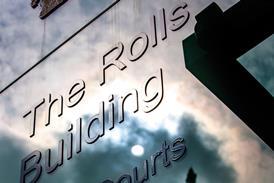COMPANY
Minority shareholders - share valuation - unfairly prejudicial conduct - quasi-partnership
Strahan v Wilcock: CA (Civ Div) (Lords Justice Mummery, Arden, Richards): 19 January 2006
The appellant (W) appealed against the decision to order him to purchase the shares in a company held by the respondent (S) at their full value, with no discount for the fact that those shares represented a minority shareholding. W had been the sole shareholder in the company, which he had formed. S had joined the company as a consultant but eventually took over the day-to-day control of the business and became the managing director.
S had been given an option to buy all W's shares, which he had not exercised. S had then been given an option to buy 10% of W's shares out of his bonuses. In that way, S had bought 50 shares from W. S had been dismissed from his employment and resigned as a director. He asked W to buy his shares at their full value on a non-discounted basis. W declined, and S presented a petition under section 459 of the Companies Act 1985, based on his exclusion from management and W's failure to purchase his shares on a non-discounted basis.
The judge held that equitable obligations were owed to S because the company was a 'quasi-partnership', that S had a legitimate expectation that in the circumstances his shares would be purchased if his employment came to an end, and that W had conducted the company's affairs in an unfairly prejudicial manner, by causing S's employment to be terminated without offering to buy back his shares at their full value.
W submitted that the judge had erred in finding that the company was a quasi-partnership, that the relationship between W and S was a purely commercial one, and that S had been given the second option merely as a stepping-stone to facilitate his acquisition of the whole of the company under the first option.
Anthony Elleray QC (instructed by Beachcroft Wansbroughs) for the appellant; Lesley Anderson (instructed by Taylors) for the respondent.
Held, the way to determine whether the company was a 'quasi-partnership' in which equitable obligations arose between the shareholders in addition to their obligations under the company's constitution was to ask whether, if the company had been incorporated when S had acquired his shares, the company would have qualified as a quasi-partnership. The judge had been entitled to conclude on the evidence that the relationship between W and S had developed into the relationship of 'quasi-partnership', Ebrahimi v Westbourne Galleries Ltd [1973] AC 360 applied.
In the circumstances, there were equitable considerations that bound W to purchase S's shares on a non-discounted basis once S had been dismissed by the company, O'Neill v Phillips [1999] 1 WLR 1092 applied. The expectation reasonably to be imputed to the parties, given their previous relationship, was that S should receive the full undiscounted value of those shares as a matter of fairness. There were no special circumstances justifying a buy-out order on a discounted basis.
Appeal dismissed.
PLANNING
Conservation areas - development orders - planning permission - telecommunications systems - prior approval notices
R (on the application of Orange Personal Communications Services Ltd & ors) v Islington London Borough Council: CA (Civ Div) (Lords Justice Laws, Jonathan Parker, Richards): 19 January 2006
The appellant local planning authority appealed against the decision ([2005] EWHC 963 (Admin)) quashing its withdrawal notices that required the respondent (X) to remove the installation of its telecommu-nications equipment. X had installed telecommunications equipment pursuant to a prior approval notice granted under part 24 of schedule 2 to the Town and Country Planning (General Permitted Development) Order 1995. The effect of the notice was that planning permission was granted in accordance with the details and plans submitted by X. However, the work carried out on the installation site did not comply with the specifications.
The site was subsequently designated a conservation area by the local planning authority. It then issued enforcement notices, requiring alterations to bring the installations in line with the plans, and X started the necessary work. Prior to completion of the work, the authority issued withdrawal notices that required the removal of the installation works on the grounds that the permitted development rights granted under the development order no longer applied, as the site was part of a designated conservation area. X applied for judicial review and the withdrawal notices were quashed.
Reuben Taylor (instructed by local authority solicitor) for the appellant; Christopher Katowski QC, Tim Buley (instructed by Burges Salmon) for the respondent.
Held, the development order had to be read as a whole. Permitted development, defined under schedule 2, part 24 class A, and development that was not permitted under schedule 2, part 24 A.1(h) had to make sense with each other. In a case that involved prior approval, once the work had started, the conservation status could not make the development unlawful. Planning permission accrued or crystallised on approval of the application by the local planning authority. While it was acknowledged that the court had to deploy concepts of accrual and crystallisation, fairness and conformity to the statutory scheme required that approach. Accor-dingly the judge was right to reach the conclusion he had.
Appeal dismissed.
FAMILY
Care proceedings - duty of care - interim orders - local authorities powers and duties - mental distress - conduct of investigations
(1) AD (2) OH (a child: by AD his litigation friend) v Bury Metropolitan Borough Council: CA (Civ Div) (Lords Justice Mummery, Laws, Wall): 17 January 2006
The appellant mother (M) and child (C) appealed against the dismissal of their claims for negligence against the respondent local authority. At the age of five months, C had sustained four rib fractures while in his parents' care. The local authority suspected that the injuries were non-accidental, and obtained an interim care order. Following a residential family risk assessment, to which M had consented, the interim care order was renewed and C was placed with foster parents for four months. The local authority was then advised that C suffered from brittle-bone disease, and that the rib fractures were not non-accidental injuries. C was returned to his parents and the care proceedings were later discharged. M and C commenced proceedings for negligence against the local authority, alleging that they had both suffered psychological harm.
The judge dismissed both claims on the basis that the local authority did not owe a duty of care to M and that, although it had admitted that it did owe a duty of care to C, any damage suffered by being removed from his parents was transient and non-justiciable. M argued that the decision in JD v East Berkshire Community NHS Trust [2005] UKHL 23, [2005] 2 AC 373 could be distinguished on the basis that in this instant case no conflict of interest arose between M and the local authority during the investigation because M had consented to the risk assessment, at which point a community of interest had come into existence and therefore a duty of care to ensure that the assessment was properly carried out. C argued that he should be compensated for his psychological suffering without the need for it to amount to a recognised psychiatric condition.
Ben Hytner QC (instructed by Aubrey Isaacson) for the appellants; Geoffrey Tattersall QC (instructed by Forbes) for the respondent.
Held, M's analysis of East Berkshire was wrong and her argument misunderstood the nature and function of care proceedings, because it imposed a wholly artificial compartmentalisation of the investigatory process by distinguishing between events that occurred before and after an interim care order was made, and it was predicated on the argument that a duty of care could arise in some parts of the investigation, but not in others.
The fact that M had agreed to the risk assessment did not import a community of interest between her and the local authority or a common law duty of care to ensure that it was properly carried out. It would be highly artificial and unprincipled if the protection against litigation afforded to social services and doctors in the investigation of child abuse ceased when an interim care order was made, or otherwise where it might be argued that there was no actual conflict of interest between the parent and the local authority.
In the context of a child abuse investigation, a duty of care could not exist at one moment and then cease to exist the next because of a shift in the factual matrix. There had been no point in the care proceedings at which the local authority owed a common law duty of care to M in relation to its investigation of C's injuries, East Berkshire applied.
It was impossible, on the facts, to identify any specific harm suffered by C of a kind giving rise to an action for damages. Apart from evidence given by M and her mother, there was no evidence that C had suffered harm, and there was nothing in the medical evidence to suggest that any distress caused by his removal from his parents was more than transitory. Appeals dismissed.
CIVIL PROCEDURE
Contribution - damages - indemnities - limitations - statutory interpretation
Aer Lingus v (1) Gildacroft Ltd (2) Sentinel Lifts Ltd: CA (Civ Div) (Master of the Roll Sir Anthony Clarke, Lords Justice Rix, Moore-Bick): 17 January 2006
The appellant company (C) appealed against the decision that it was out of time within the meaning of section 10 of the Limitation Act 1980 in making its claim for contribution against the respondent companies (G and S). C's employee (V) had been badly injured at work by the malfunction of a document lift supplied to C, which had been installed by G as primary contractors, and S as subcontractors. In an action against C, G and S, V obtained judgment by consent against C. His proceedings against G and S were discontinued, with C agreeing to pay their defence costs. C then sought contributions and indemnities from G and S under the Civil Liability (Contribution) Act 1978, beginning well within two years of V's final judgment, but well outside the two years following the judgment on liability alone.
The issue in this appeal was which judgment marked the start of the statutory two-year limitation period under section 10 for C's claim against G and S, with C insisting that the reference to 'judgment' or 'award' was ambiguous but that, when properly interpreted in context, was a reference to a judgment that established not only liability but also quantum. G and S submitted that the language of section 10(1)(a) was clear: just as liability under section 1 of the 1978 Act referred merely to liability, without any determination of quantum, so section 10 of the 1980 Act did the same, save that there was need, to start time running, of the establishment of liability by judgment or award, which was why the wording was 'held liable'. They argued that there was no need, however, for the ascertainment of any quantum, and no such need was expressly stated, for a judgment on liability with damages to be assessed would do, with the only alternative a payment, agreed or made. In that case, they contended, quantum would be established because agreed, and that would start time running, whether or not the defendant accepted or continued to dispute liability.
Michael Pooles QC, Martin Porter (instructed by Beachcroft Wansbroughs) for the appellant; Jonathan Harvey (instructed by Kennedys) for the first respondent; Nick Heathcote Williams (instructed by John A Neil) for the second respondent.
Held, the issue was left open by authority, George Wimpey & Co Ltd v British Overseas Airways Corporation [1955] AC 651 considered. The language of the 1978 Act was not the same as that of the Law Reform (Married Women and Tortfeasors) Act 1935 considered in Wimpey. Moreover, the 1935 Act had not been provided with its own limitation provision for a claim in contribution until the Limitation Act 1963, which post-dated Wimpey. Nevertheless, it was tempting to see, in section 4 of the 1963 Act, substantially reproduced in section 10 of the 1980 Act, the answer given to some of the issues raised in Wimpey. Whether it was true of the 1978 Act, as the Court of Appeal held and the House of Lords was prepared to assume of section 6(1)(c) of the 1963 Act in Wimpey, that no cause of action arose until judgment, it was not necessary to decide.
Nevertheless, the reflection of the language in Wimpey in the 1963 Act and now in the 1980 Act, together with the reasoning of the Court of Appeal in Wimpey reflecting the position at common law, and the Lords' understanding of that reasoning, strongly suggested to the court that the correct interpretation of section 10 was that time did not begin to run until the quantum of the claimant tortfeasor's liability had been ascertained, either by judgment or award or agreement. That was consistent with the language of section 10 and the textual and background considerations supported one another towards that conclusion.
The judgment or award referred to in section 10(3) of the 1980 Act as setting the relevant date for the running of time against a tortfeasor who sought contribution under the 1978 Act was a judgment or award that ascertained the quantum, and not merely the existence, of the tortfeasor's liability.
Appeal allowed.
INSURANCE
Burden of proof - case management - discretion - jurisdiction clauses - reinsurance - stay of proceedings
(1) Konkola Copper Mines plc (2) ARH Ltd SA v Coromin Ltd & ors & Swiss Reinsurance Co & ors (part 20 defendants): CA (Civ Div) (Master of the Roll Sir Anthony Clarke, Lords Justice Rix, Richards): 17 January 2006
The appellant reinsurers (R) appealed against the decision ((2005) EWHC 898 (Comm)) refusing to stay the part 20 proceedings against them. The claimant (K) owned and operated a copper mine in Zambia. An avalanche of rock and mud had seriously damaged the mine and killed ten miners. There was an issue as to whether the mine had suffered a 'collapse' or a 'landslip', for insurance purposes.
There were potentially up to three layers of insurance: local insurance in Zambia that provided cover for named perils, including collapse but not landslip, and incorporated a local law and jurisdiction clause; a further layer of insurance under an all-risks policy subject to English law and jurisdiction issued by the defendant (C), which at the time of loss was a captive insurer set up to insure or reinsure risks relating to companies within the group of which K was then a member; and a third layer of insurance provided by R.
K sued C and the Zambian insurers. K and the Zambian insurers had agreed that the liability of the latter should be determined in Zambian proceedings under Zambian law and that the English proceedings against them should be stayed, and that agreement was embodied in a consent order.
C, as the surviving defendant in the English proceedings, brought part 20 proceedings against R. The judge declined to stay those proceedings permanently or pending the outcome of K's claims against the Zambian insurers and C. Since the hearing, C had added the reinsurance brokers to its part 20 claim.
R submitted that the part 20 proceedings were premature and, to avoid inconsistent decisions, the judge should have exercised his jurisdiction to stay the proceedings on case management grounds, pending the outcome of K's proceedings in Zambia, which would determine the central question whether the incident at the mine was or was not a 'collapse'; that the reinsurance contract was governed by an exclusive Zambian jurisdiction clause, so that the part 20 proceedings should be stayed in favour of Zambian proceedings, that C bore the burden of proof on that issue as the party seeking jurisdiction in England and that the judge had applied the wrong test.
Joe Smouha QC, David Lord (instructed by DLA Piper Rudnick Gray Cary) for the appellants; Steven Berry QC (instructed by Ince & Co) for the respondents.
Held, a case management stay was possible but it required rare and compelling circumstances, Reichhold Norway ASA v Goldman Sachs International [2000] 1 WLR 173 applied. It would be unfair to C to stay its part 20 claim, even temporarily, and thus leave it exposed to K's claim because it was no longer possible, after the consent order, to stay K's English claim as well as C's part 20 claim, pending the resolution of K's Zambian claim, and there was no good reason to believe that K's real interest was in its Zambian claim and that it was itself uninterested in carrying for-ward its English claim, pending the resolution of its Zambian claim.
K's claim in England was properly based jurisdictionally, was a case in good standing and was based on an English law and jurisdiction contract, at least in part made or negotiated through the reinsurance brokers. It would be wrong to look at the litigation by concentrating simply on the Zambian claim, as much as it would be wrong to concentrate simply on the English proceedings.
In all the circumstances, a case management stay was not in the interests of justice. For the same or similar reasons, it would not be right for the court to interfere with the exercise of the judge's discretion not to enforce a Zambian exclusive jurisdiction clause, even on the hypothesis that R had established a much stronger argument in favour of the applicability of such a clause to C's part 20 claim.
Both K's and C's claims were jurisdictionally soundly based in England. Where a choice between such claims did not have to be made, it was possible to think of each version as being a good arguable case. R had not shown that their case was sufficiently good either to be preferred to C's case or to displace the otherwise established jurisdiction in England. On that basis, R, who bore the burden of giving effect to their clause, would fail in their jurisdictional challenge. However, since the stay application failed as a matter of discretion, it was unnecessary to decide whether R's case in favour of a Zambian clause or C's case in favour of an English clause had much the better of the argument, even if that was the right test, Canada Trust Co v Stolzenberg [1998] 1 WLR 547, Carnoustie Universal SA v International Transport Workers Federation [2002] EWHC 1624 (Comm), [2002] 2 All ER (Comm) 657, Knauf UK GmbH v British Gypsum Ltd [2001] CLC 1141 and The Bank of Tokyo-Mitsubishi Ltd v Baskan Gida Sanayi Ve Pazarlama AS [2004] EWHC 945 (Ch), [2004] 2 Lloyd's Rep 395 considered.
Appeal dismissed.
DAMAGES
Trespass to land - correct approach to assessment of damages in lieu of injunction
Joseph W Horsford v Lester B Bird & ors: PC (Ant) (Lords Hope of Craighead, Scott of Foscote, Walker of Gestingthorpe, Mance, Baroness Hale of Richmond): 17 January 2006
The appellant (H) appealed against the decision of the Court of Appeal of Antigua and Barbuda reducing his award of damages for trespass to land on the basis that no case for aggravated damages had been made out.
A boundary wall and fence constructed for the respondent (B) by contractors building B's new house had encroached on H's neighbouring undeveloped land, and, in effect, added some 455 square feet of H's land to B's garden. H's claim for the degra-dation to his land that had been caused by B's contractors and their machinery had been settled by a payment by the contractors of a sum of East Caribbean (EC)$67,948 (£14,296). H's claim for a mandatory injunction for the removal of the offending wall and fence was refused by the trial judge, who instead ordered B to pay damages in the sum of EC$75,000, which amount included a substantial sum for aggravated damages. B appealed against the quantum of that award and the Court of Appeal took the view that no case for aggravated damages had been established. The damages were reduced to EC$13,650, being the value of the 455 square feet of undeveloped land at EC$30 per square foot.
The appellant in person; Peter Knox (instructed by Collyer-Bristow) for the respondents.
Held, the basis for awarding aggravated damages did not exist. Trespass to land accompanied by high-handed, insulting or oppressive conduct might warrant an award of aggravated damages, but there was no evidence of any such conduct associated with the building of the wall on the wrong line. The conduct, which the judge had taken into account, included the statement in B's defence that he had not known that the land in question was owned by H, and the fact that B had not answered letters written to him by H. That conduct had its counterpart in a great deal of litigation and did not justify an award of aggravated damages.
The Court of Appeal had erred in awarding only the value of the encroached-on piece of land without considering the extent to which the piece of land had enhanced the amenities of B's new house. The encroached-on strip of land had made possible a drive around B's swimming pool. B had also been spared the expense of rebuilding the wall on the correct line.
By building his wall on H's land and thereby incorporating a piece of H's land into his garden, B had given the expropriated land a value to himself considerably in excess of its value simply as 455 square feet of an undeveloped plot. That was the value that should have been taken into account in assessing the damages to be paid in lieu of a mandatory injunction for the removal of the wall. On the basis that the value of the piece of land as part of an undeveloped plot was EC$13,650, its value to B as part of the garden of his new house would have been at least double that figure and the sum of EC$27,300 was substituted as the value of the land in the award of damages.
The Court of Appeal had also failed to take into account the fact that ever since 1990, when the wall had been completed, B had had the exclusive use and benefit of the encroached-on piece of land. H had a clear claim to damages in the form of mesne profits for the use made of his land by B. Any such claim for a period more than six years before the commencement of proceedings was statute-barred. The period for which mesne profits could be claimed was, in the circumstances, eight years and three months. The quantum of the claim was assessed on a yearly basis as a percentage of the capital value of the piece of land in question. The capital value was taken to be EC$27,300, and an annual rate of 7.5% of that capital value represented reasonable mesne profits. The total figure for mesne profits was EC$16,892 and accordingly the total award of damages was EC$44,192.
Appeal allowed.
CRIMINAL
Access restrictions - discretion - right to fair and public hearing - state security - terrorist investigations
R v (1) Crown Court at the Central Criminal Court ex parte A (2) Times Newspapers Ltd (3) Guardian Newspapers Ltd (4) British Broadcasting Corporation: CA (Crim Div) (Sir Igor Judge (President QB), Mr Justice Openshaw J, Sir Paul Kennedy): 13 January 2006
The appellants (X), who comprised the defendant in a criminal trial (Y) and three news organisations, appealed against an order that part of the evidence to be given at Y's trial should be heard in camera.
Y had been detained for about ten months in Pakistan prior to his transfer to the UK, where he was arrested and charged on an indictment alleging that he and six others had been parties to a conspiracy to cause terrorist explosions in the UK. Y alleged that, throughout his detention, he had been tortured by British, American and Pakistani intelligence authorities.
In advance of Y's trial, the Crown had obtained an order that for reasons of national security and the avoidance of harm to the due administration of justice, any evidence, apart from evidence given by Y, about his treatment whilst out of the jurisdiction should be heard in camera. The main issue at this hearing was whether the appeal against that order should be determined without a hearing as provided by rule 67.2 of the Criminal Procedure Rules 2005. X submitted that rule 67.2 should be read as conferring a discretion on the court to hold a hearing in order to comply with the entitlement under article 6 of the European Convention on Human Rights to a fair and public hearing.
Furthermore, Y argued that it was irrational for the Crown to argue that a risk to national security could be guarded against by prohibiting general disclosure to the public, but permitting disclosure to an alleged terrorist, the legal advisers and jurors.
Patrick O'Connor QC, H Mullan for A; David Waters QC, M Heywood, D Atkinson for the Crown; Keir Starmer QC, A Hudson for Times Newspapers Ltd, Guardian Newspapers Ltd and BBC.
Held, this appeal concerned the process that should govern the exceptional cases that fell outside the principle that justice had to be administered in public, R (on the application of Hammond) v Secretary of State for the Home Department [2005] UKHL 69, [2005] 3 WLR 1229 and Ekbatani v Sweden (1988) 13 EHRR 504 considered.
The order reflected the judge's analysis of the needs of national security, and the potential prejudice to them and the interests of justice that would be caused by an open court hearing. If the decision that part of the trial should take place in camera was right, there was no justification for concluding that the language of rule 67.2(7) should be interpreted as conferring a discretion to hold an oral hearing. If the judge's order was wrong, it would cease to have effect. Accordingly, the absence of a discretion was not incompatible with the convention, and the court could not ignore the express requirement that the determination of the appeal should take place without a hearing.
The substantial risk to national security and to the administration of justice without an order for an in camera hearing had been unequivocally established. It would enable Y to be provided with material that might assist in the preparation of his defence, while simultaneously ensuring that the Crown was not forced to discontinue the prosecution. The trial would proceed fairly to both sides, so far as practicable diminishing the risks to national security.
Appeal dismissed.
Conditional discharge - convictions - indecent photographs of children - notification - sex offenders
R v Gary Dean Longworth: HL (Lords Nicholls of Birkenhead, Hoffmann, Hope of Craighead, Rodger of Earlsferry, Lord Mance): 26 January 2006
The appellant (L) appealed against the decision ([2004] EWCA Crim 2145) that he was subject to the notification requirements of the Sex Offenders Act 1997.
L had pleaded guilty to counts of making an indecent photograph of children, contrary to section 1(1)(a) of the Protection of Children Act 1978, and of possessing indecent photographs of children, contrary to section 160(1) of the Criminal Justice Act 1988.
In relation to each offence, the sentencing judge imposed conditional discharges under section 12 of the Powers of Criminal Courts (Sentencing) Act 2000 for 12 months, and further ruled that there was a requirement to notify under the 1997 Act for a period of five years from the date of conviction.
The Court of Appeal dismissed L's appeal against the notification requirement, but certified as a point of law of general public importance the question whether the provisions of section 14(1) of the 2000 Act had the effect of preventing an order for conditional discharge made on conviction for an offence other than under the 1997 Act from being classed as a conviction for the purposes of the 1997 Act, and thus avoiding the notification requirements under the 1997 Act.
Iain Goldrein QC and Michael Davies (instructed by Frank Howard) for the appellants; David Perry and Louis Mably (instructed by the Crown Prosecution Service) for the respondents; Steven Kovats (instructed by the Treasury Solicitor) for the Home Secretary as intervener.
Held, any requirement to notify under the 1997 Act arose at once on conviction, independently of any order that was or could be made by the court, and the sentencing judge had no power to determine whether any and what notification requirements arose under the 1997 Act, consequent on the orders of conditional discharge that he made.
However, the fact that he purported as part of the sentencing exercise to determine the issue entitled L to appeal. It was appropriate to set aside that part of the judge's sentencing remarks and ruling that purported to order L to register for five years under the 1997 Act.
The effect of section 14(1) of the 2000 Act was to deem there to be no conviction for the purposes of section 1(1)(a) of the 1997 Act. The focus of the phrase 'the purposes of the proceedings' in section 14(1) of the 2000 Act was narrow. It was on the legal proceedings actually before the court. The proceedings under the 1978 and 1988 Acts were on no view brought under the 1997 Act. The purposes of proceedings under the 1978 or 1988 Act could not plausibly be said to embrace the bringing of subsequent proceedings under section 3 of the 1997 Act for failure to notify under section 1 of that Act, and so section 14(1) of the 2000 Act would on any view preclude reliance on any such conviction for the purposes of sanctioning such a failure.
The view that Parliament had not envisaged that the notification requirements of the 1997 Act should apply to persons discharged absolutely or conditionally was supported by the subsequent legislative history. Section 134(2) of the Sexual Offences Act 2003 clearly indicated that it was Parliament's understanding that, in respect of any conviction prior to the commencement of that part of the 2003 Act in respect of which the offender was discharged absolutely or conditionally, section 14(1) of the 2000 Act would have the effect of deeming such conviction not to have occurred for the purpose of the notification requirements under the 2003 Act and, inferentially, under the predecessor 1997 Act. The appeal court had been wrong to rule that L was subject to any notification requirements consequence of the convictions in respect of which he was conditionally discharged.
Appeal allowed.
EMPLOYMENT
Jurisdiction - overseas employees - place of work - territorial application - unfair dismissal
Serco Ltd v Lawson; Botham (FC) v Ministry of Defence; Crofts & Ors v Veta Ltd & Ors: HL (Lords Hoffmann, Woolf, Rodger of Earlsferry, Walker of Gestingthorpe, Baroness Hale of Richmond): 26 January 2006
The appellants (L, B and V) appealed against decisions ([2004] EWCA Civ 12, [2004] 2 All ER 200 and [2005] EWCA Civ 599, [2005] ICR 1436) regarding the territorial scope of section 94(1) of the Employment Rights Act 1996. In L's case, the employer was a substantial UK company that had engaged L to work as a security guard on Ascension Island. In B's case, the Ministry of Defence had employed B as a UK-based youth worker at various establishments in Germany. In V's case, the employee had been employed as a pilot by a Hong Kong company but was based in the UK under a permanent basings policy.
The Court of Appeal held that section 94(1) did not apply to L or B as all the services had been performed by the employees abroad. However, in V's case, the court concluded that the employee's basing in the UK was sufficient for the employment tribunal to treat section 94(1) as applicable. The issue for determination was what connection between Great Britain and the employment relationship was required to make section 94(1) the appropriate choice of law in deciding whether an employee could complain that his dismissal was unfair.
Jacques Algazy and Paul Spencer (instructed by Mills Kemp & Brown) for the appellant in Serco; Thomas Linden (instructed by Morgan Cole) for the respondents in Serco; Frederic Reynold QC and Philip Mead (instructed by Dean Wilson Laing) for the appellant in Botham; Jonathan Crow and Philip Coppel (instructed by Treasury Solicitor) for the respondents and also for the Foreign & Commonwealth Office as intervener in Botham; James Goudie QC and Anya Proops (instructed by Eversheds) for the appellants in Crofts; David Griffiths-Jones QC and Joanna Heal (instructed by Simpson Millar) for the respondents in Crofts.
Held, the question in each case was whether section 94(1) applied to a particular case, notwithstanding its foreign elements. That was a question of the construction of section 94(1) and it would be a mistake to try to formulate an ancillary rule of territorial scope, in the sense of a verbal formula, such as section 196 of 1996 Act used to provide before its repeal, which must then itself be interpreted and applied. Nevertheless, the fact that the courts were dealing in principles and not rules did not mean that the decision as to whether section 94(1) applied was an exercise of discretion. It either applied to the relationship or it did not. In the case of peripatetic workers, for the purposes of section 94(1), the place of employment remained determinative, Todd v British Midland Airways Ltd [1978] ICR 959 applied. The question of whether, on any given facts, a case fell within the territorial scope of section 94(1) should be treated as a question of law. However, that was a question of degree on which the primary fact-finder was entitled to considerable respect.
In V's case, the tribunal had been entitled to reach the conclusion that the centre of the employee's operations was in the UK and V's appeal was therefore dismissed. In the case of expatriate workers, the circumstances would have to be unusual for an employee who worked and was based abroad to come within the scope of the British labour legislation. However, there could be exceptional cases. The fact that an employee was British and had been recruited in Britain was insufficient to take the case out of the general rule, but an employee who had been posted abroad by a British employer for the purposes of a business carried on in Britain might come within the scope of the British legislation. Another example was an expatriate employee of a British employer who was operating within what amounted for practical purposes to an extra-territorial British enclave in a foreign country. In the cases of L and B, they had equally strong connections with Great Britain and British employment law and their appeals were therefore allowed. Their cases were remitted to the tribunal for rehearing.
Judgment accordingly.

























No comments yet